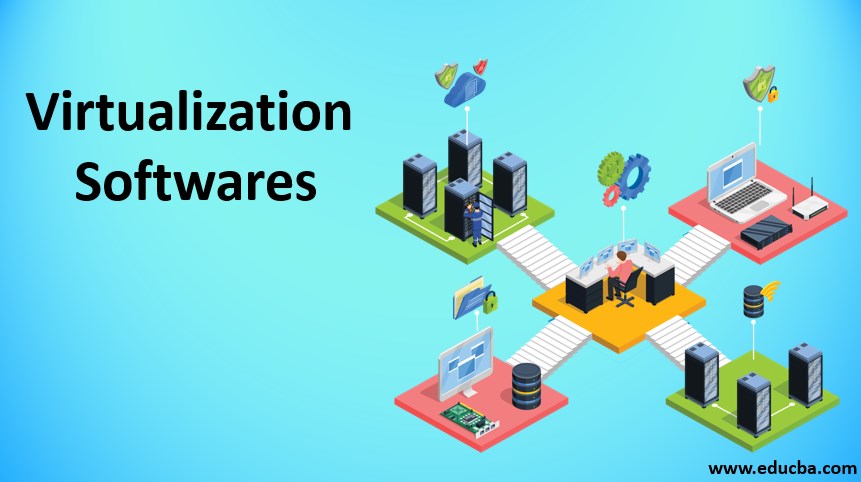Updated May 30, 2023

Introduction to Virtualization Softwares
Virtualization software can be defined as a computer program that helps achieve IT abstraction. To make it clear, it can be said as it helps in hiding or masking the physical resources from the end-user.
In this article, we will see what Virtualization Software is and how to achieve virtualization using it. Virtualization can be explained as the computer inside another computer. Generally, it is used to share computer resources and reduce the cost of infrastructure by businesses; different software and platforms are available in the market to achieve virtualization. We will also discuss how different software is used to achieve this. We will also see the pros and cons of each software and discuss some of the use cases where this software achieves virtualization.
Benefits of Using Virtualization Software
- One can use multiple operating systems in a single computer.
- One can share the components of the single operating system hosted centrally on multiple computer systems located at different geographical locations.
- With virtualization software, one can utilize the total capacity of the computer system, as this helps improves the performance in terms of speed and functionality.
- Virtualization software also provides security options that help keep the data and the resources shared among different users safe. The virtualization feature known as a snapshot allows users to take a backup of the current working system and restore it whenever it encounters trouble.
Different Virtualization Softwares
Now let’s discuss the different Virtualization Software which is available in the market to do virtualization:
1. SolarWinds Virtualization Manager
- This is a kind of management software for all virtual machines; this software helps in tracking the performance and fixing if there are any performance issues, such as memory and storage.
- It provides complete visibility for all the virtual machines attached to the system.
- Users can manually fix all performance issues using the tool and trigger actions whenever problems are reported.
- This tool is also helpful in maintaining the cloud platforms and checking their usage or performance.
- The tool has triggers and automatic indications, which helps the user monitor everything properly.
2. VMware Fusion
- This software is for Mac users who can run Windows, Linux, Unix, and any other operating system on their Mac using this software.
- VMware Fusion also supports cloud-based platforms for virtualization
- The VMware fusion pro version provides the facility of integration of different development tools with it
- This software is very simple to use and can support real-time demonstration for different software and applications
- It also has a rollback point where you can save the last proper working versions of the OS and can go back to it whenever required.
- The only con for this is that the drag-and-drop functionality is not proper and needs improvement.
3. Parallels Desktop
- This software also allows Mac users to use Windows and other operating system.
- This supports Windows 10 and Mac OS High Sierra.
- They provide many different tools that are very useful for daily tasks.
- The view for this software is excellent, and it requires no reboot during installation.
- The application inside the virtual OS delivers high-speed performance and is easily usable without lag.
4. Virtual Box
- This virtual box comes from Oracle, and the best part of them is it’s very.
- Different operating systems are run using this software in Windows.
- At a time, it can host up to 4 operating systems.
- It supports the drag-and-drop feature, and the window can be minimized and resized.
5. VMware Workstation
- This is the most popular and widely used virtualization software.
- It supports multiple operating systems, especially Windows and Linux.
- It’s for developers and IT professionals who generally work on different OS.
- Multiple applications can be integrated with this software.
- This software also supports cloud applications.
6. QEMU
- Users utilize this software for hardware virtualization
- This is also open-source, free software.
- There is no restriction for the host OS, meaning this software can run on Mac and a Windows system.
- But the only con in this is it’s not at all user-friendly.
7. Windows Virtual PC
- This software comes with the Windows operating system.
- This is only for Windows users, and it is very much user-friendly.
- One can use the print option inside the virtual box and run multiple virtual machines simultaneously.
- The only drawback for this one is that it doesn’t support any other OS apart from Windows.
8. Microsoft Hyper V
- This software comes bundled with Microsoft windows server 2008 and later.
- It provides hardware virtualization.
- This software supports the running of multiple virtual machines.
- This supports the cloud as well, such as Microsoft Azure.
- This supports multiple versions of the Linux operating system.
9. RedHat Virtualization
- This virtualization software comes from the Redhat family.
- The Redhat software company promised excellent performance for the applications running inside the virtual machine because they have written this software in Java.
- It’s an open-source system, so any user can tweak the code and make it work for his use and application.
- It’s free software, and the installation for this is very easy.
Conclusion
In this article, we have discussed how to achieve virtualization and what exactly virtualization software is. We have also discussed the various software available to achieve virtualization and its pros and cons.
Recommended Articles
This is a guide to Virtualization Softwares. Here we discuss the introduction, benefits, and the top 9 virtualization softwares in the market. You can also go through our other related articles to learn more –

